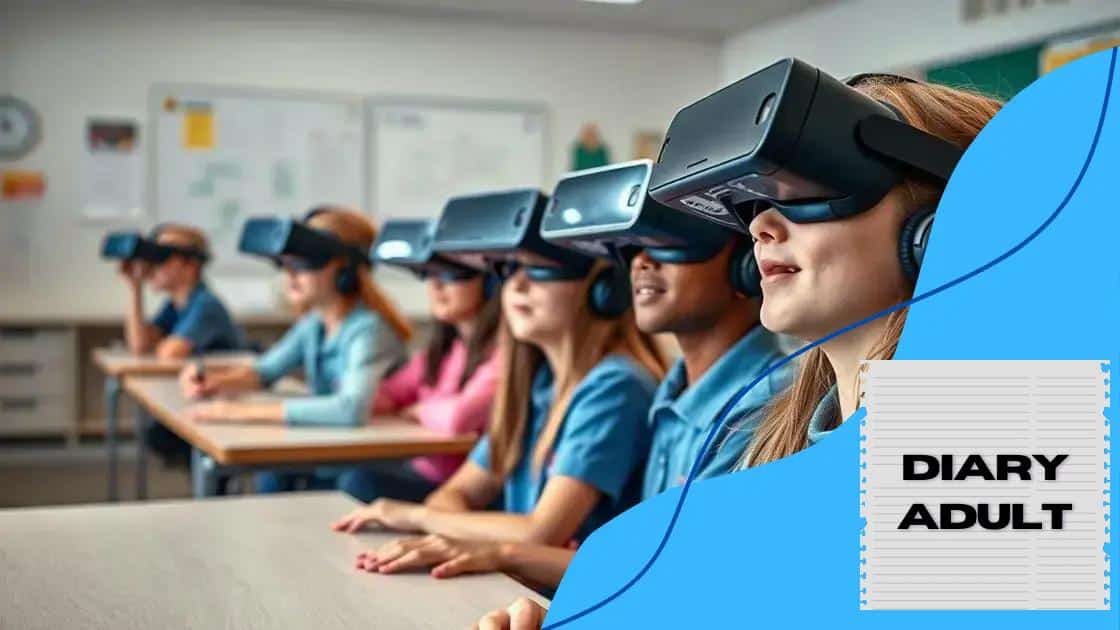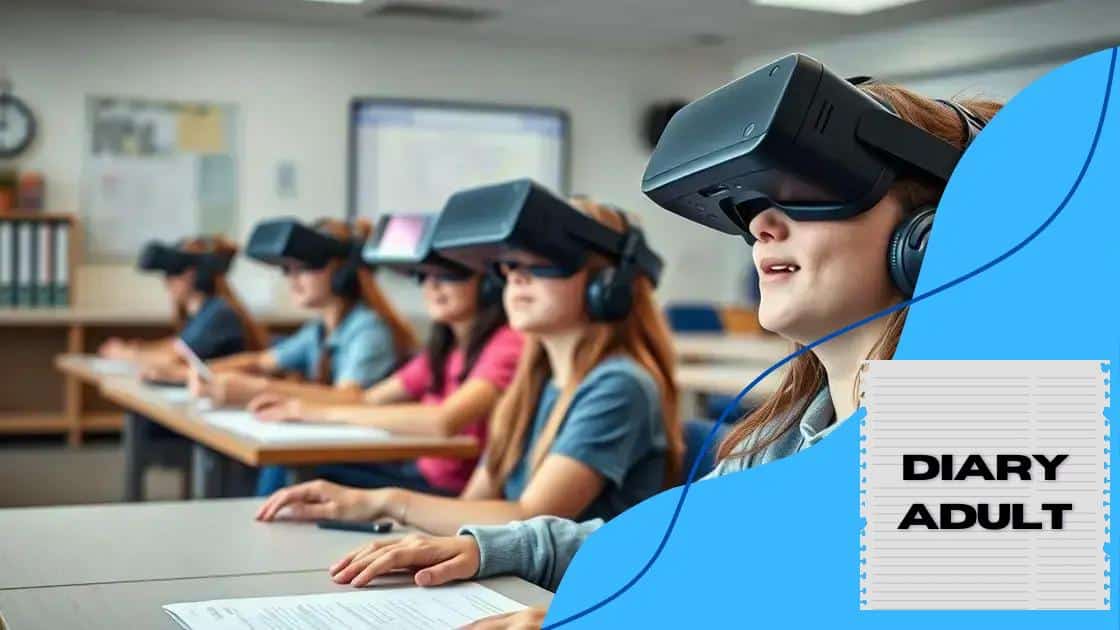Virtual reality for engaging STEM education experiences

Virtual reality offers engaging STEM education experiences by providing immersive learning environments that enhance student participation, retention, and collaboration through interactive simulations and real-world applications.
Virtual reality for engaging STEM education experiences is transforming the way students learn. It immerses them in practical scenarios that spark curiosity and deepen understanding.
Understanding virtual reality and its applications
Understanding virtual reality and its applications is essential for grasping its impact on education. This technology allows students to experience learning in a whole new way, making complex concepts easier to understand.
What is virtual reality?
Virtual reality, or VR, refers to a simulated environment created by computer technology. It immerses users in a three-dimensional world, which they can interact with using specialized equipment.
Key applications of VR
The applications of VR in education are vast. It enhances learning by providing immersive experiences. Here are some key areas where VR can be applied:
- Science simulations: Students can conduct experiments in a safe, virtual lab.
- Historical explorations: VR lets students visit historical sites and experience events firsthand.
- Mathematics visualization: Complex geometric concepts can be visualized in 3D, aiding understanding.
- Engineering and design: Students can visualize prototypes and designs before implementation.
These applications show how virtual reality can change traditional learning methods. By creating engaging simulations, students can retain information more effectively. The benefits are clear, and the potential for VR in education continues to grow as technology advances. Educators now have the chance to inspire and motivate students through these unique experiences, opening doors to new learning methodologies.
Benefits of VR in STEM education
The benefits of VR in STEM education are profound and can revolutionize the learning experience for students. Through immersive simulations, learners can engage with subjects in a way that traditional methods cannot match.
Enhanced Engagement
One of the primary benefits of VR is enhanced engagement. Students are often more motivated when they can explore content through experience. The interactivity of VR draws students in, making learning enjoyable.
Improved Retention
Research indicates that students who use VR are likely to retain information better. When students can visualize concepts in a three-dimensional space, they grasp complex ideas more thoroughly. This retention is essential in subjects like science and math, where understanding builds upon itself. The process of learning becomes more active, which is beneficial for digestive information.
- Real-world applications: VR allows students to see how concepts apply in the real world.
- Safe experimentation: Students can conduct experiments without real-world risks, encouraging trial and error learning.
- Diverse learning styles: VR caters to visual, auditory, and kinesthetic learners, making it inclusive for all types of students.
- Collaboration: Many VR applications allow students to work together, fostering teamwork and communication skills.
Along with retention and understanding, VR creates emotional connections to the material being learned. When students are immersed in a simulation, they feel like they are truly part of the experience. This emotional involvement can strengthen their connection to the subject matter, leading to a deeper appreciation for STEM fields.
How VR enhances student engagement

How VR enhances student engagement is a fascinating topic that highlights the power of immersive technology in the classroom. By using virtual reality, educators can create captivating environments where students interact directly with the content.
Creating Immersive Experiences
One of the main ways VR enhances engagement is by creating immersive experiences. Instead of passively reading from a textbook, students can explore 3D environments and engage with complex concepts in real time. This active participation helps students feel more involved and interested in their learning.
Interactive Learning
Furthermore, VR promotes interactive learning. Students can perform experiments, manipulate objects, and explore scenarios in a virtual setting. For instance, a student could simulate a chemical reaction or walk through ancient ruins. Such active tasks lead to increased motivation and enthusiasm.
- Real-time feedback: Students receive immediate feedback during their virtual experiences, enhancing learning and retention.
- Collaboration: VR often allows students to work together in a virtual space, fostering collaboration and teamwork.
- Personalized learning: Each student can progress at their own pace, making learning tailored to individual needs.
- Emotional connection: Immersive experiences can evoke emotions, helping students develop a deeper connection to the material.
Moreover, VR creates a safe space for exploration. Students can take risks without real-world consequences, leading to a more profound understanding of subjects. Experiences in VR can motivate students to learn more, encouraging them to delve deeper into STEM topics.
Successful case studies of VR in classrooms
Successful case studies of VR in classrooms demonstrate how this technology can enhance learning experiences and outcomes. Many schools and institutions have embraced virtual reality to engage students across various subjects effectively.
Case Study 1: Science Education
In one example, a high school in California integrated VR into their biology curriculum. Students used VR to explore the human body in 3D. This immersive approach helped them visualize complex processes like the circulatory system and cellular functions. As a result, test scores improved significantly, with students reporting higher interest in science.
Case Study 2: History Lessons
Another successful implementation occurred in a middle school in New York, where VR was used to bring history lessons to life. Students took virtual field trips to ancient civilizations such as Egypt and Greece. They walked through the pyramids and visited important landmarks, which deepened their understanding of historical events. Feedback indicated that students were more engaged and retained information better than with traditional teaching methods.
- Improved engagement: All students participated actively, which led to increased curiosity about the subjects.
- Enhanced retention: Many students reported that VR helped them remember key facts and concepts.
- Accessibility: Virtual reality made learning more accessible to students with different learning styles.
- Collaboration: Group projects in VR fostered teamwork and communication skills.
These case studies highlight how VR can create dynamic, interactive learning environments. Schools investing in this technology see positive changes not only in academic performance but also in student attitudes towards learning.
Future trends of VR in education
The future trends of VR in education are promising and exciting. As technology advances, we can expect even more innovative uses of virtual reality in classrooms. Educators are exploring new ways to enhance learning experiences for students.
Increased Accessibility
One of the key trends is increased accessibility. VR technology will become more affordable, allowing more schools to integrate it into their curricula. As costs go down, a wider range of students can benefit from immersive learning experiences.
Personalized Learning Environments
Another trend is the shift towards personalized learning environments. With VR, education can cater to individual learning styles. Students can engage with the materials at their own pace, creating a more effective educational journey.
- Adaptive learning: VR platforms will use AI to adjust content based on student performance.
- Collaborative experiences: Virtual classrooms may allow students from different countries to learn together in shared experiences.
- Integration with other technologies: Combining VR with AR (augmented reality) will create hybrid learning environments that enrich education.
- Expanded subject offerings: Subjects that are harder to teach, like complex sciences or arts, will become more accessible through immersive VR experiences.
Moreover, as educators become more comfortable with VR technology, we will likely see an increase in creative ways to implement it in lesson plans. Teachers may design interactive lessons that allow students to simulate historical events, conduct scientific experiments, or explore creative arts in dynamic ways.
As these future trends unfold, VR in education has the potential to transform traditional teaching methods, making learning more engaging and effective for all students.
In conclusion, virtual reality is changing the landscape of education by making learning more engaging and interactive. As we explored recent trends, case studies, and the benefits of VR, it is clear that these technologies can enhance student learning experiences. Looking forward, we anticipate exciting advancements that will further integrate VR into classrooms, making education accessible and personalized for all students. Embracing these changes will not only boost academic performance but also inspire a new generation of learners.
FAQ – Frequently Asked Questions about Virtual Reality in Education
How does VR enhance student engagement?
VR enhances engagement by creating immersive learning experiences, allowing students to interact with 3D environments, making learning more enjoyable.
What are some successful case studies of VR in classrooms?
Successful case studies include students exploring biology through 3D models of the human body and taking virtual field trips to ancient civilizations for history lessons.
What future trends can we expect for VR in education?
Future trends include increased accessibility, personalized learning environments, and the integration of VR with other technologies to create collaborative experiences.
Is VR technology becoming more accessible for schools?
Yes, as technology advances and costs decrease, more schools will be able to incorporate VR into their curricula, benefiting a wider range of students.





